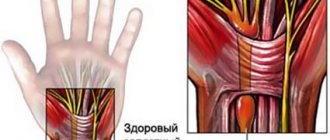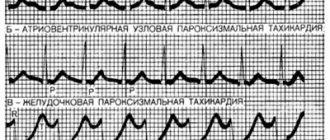When does a panic attack occur?
The mechanism of panic paroxysm is based primarily on the psychological factor, and the vegetative one is considered secondary. During an attack, there is an increase in the negative emotional background for 10–15 minutes, then a gradual decline. The provoking trigger is three factors, together or one at a time:
- psychogenic - conflicts and personal tragedies, as well as abstract factors of an informational nature;
- physiogenic - taking certain pharmacological drugs, steroids, alcohol, drugs, weather changes, overexertion, prolonged exposure to the sun, acclimatization);
- biological - fluctuations in hormones due to pregnancy, menstruation, abortion, childbirth, menopause, the onset of sexual activity, and the use of contraceptives.
The diagnosis is made if the attack recurs at least twice in the presence of several signs.
Vegetative symptoms include:
- sweating;
- feeling of a lump in the throat;
- a sharp rise in blood pressure;
- heartbeat;
- dry mouth;
- heat;
- chills;
- nausea;
- diarrhea.
From psychological:
- thoughts of approaching death, fear of dying;
- derealization;
- feeling of loss of self;
- dizziness, etc.
Quarantine is over - now we are not in danger?
Unfortunately no. The period of self-isolation may indeed be over, but the coronavirus pandemic is still far from over. Moreover, more and more experts agree that a new wave of the disease awaits us in the next few months. And even if it is easier than the first, we still have a fairly long period of time ahead of us, during which we will most likely be very worried about the health of ourselves and our loved ones, as well as experience significant inconvenience and a strong decrease in our usual quality of life. All this, together with previously experienced stress, can become a trigger for panic attacks.
PA during menstruation: causes of occurrence
In women of fertile age, menstruation and panic attacks are closely related, and panic attacks are considered a typical, common, although not inevitable, manifestation of PMS. Let's consider the main manifestations of this disease.
Panic attacks before menstruation
The disorder is common mainly among female residents of megacities aged 25 to 45 years. Panic attacks before menstruation are more pronounced and occur with greater frequency. During this period, a woman experiences strong emotional stress and is prone to impulsive actions. Medicine considers the occurrence of attacks against this background as the result of hormonal fluctuations.
The patient may search for the reason for the recurrence of attacks for quite a long time. At the same time, the tests are normal, there are no serious pathologies, but every time the “red days of the calendar” approach, the attacks are repeated. And if panic usually results from stressful situations, then before menstruation it occurs for no apparent reason. A woman can be overcome by a wave of groundless fear, even when she is at work, among familiar people, performing her usual duties. And at a young age, this condition is especially difficult to cope with, since girls have not yet developed full adaptation to their living space.
Important! The insidiousness of panic disorder when menstruation approaches is also the fear of recurrence. Against the background of PMS, a panic attack anticipation syndrome is formed. The disturbing memory of the emotional state intensifies as it approaches the beginning of menstruation and naturally causes a repetition of the attack of fear. The connection between the attack and menstruation becomes inextricable, and the woman’s fears for her health intensify.
Panic attacks during menstruation
In the first half of the cycle, women's estrogen levels increase, and in the second - progesterone. These fluctuations are physiological and are aimed at cleansing the uterus to prepare it for a possible pregnancy. A woman experiences panic attacks during menstruation much more acutely, since the imbalance of the autonomic system increases due to the change in phases of the cycle, and the production of the joy hormone, endorphin, decreases.
Symptoms of a panic attack during menstruation may include mood swings, feelings of despair, increased pain in the lower abdomen, and severe headaches.
Sometimes, due to regular panic attacks before menstruation, agoraphobia develops - the fear of being in public. This is more likely to happen if attacks are repeated in crowded places, as there is a subconscious connection between panic and large crowds of people.
How do menstruation occur with VSD and methods of relieving the condition?
Every fifth girl has been diagnosed with VSD - vegetative-vascular dystonia - at least once in her life. Despite the fact that today there is no such pathology according to the international classification of diseases, many doctors continue to use the term. It often sounds in a situation where the doctor simply does not know what is wrong with the girl, or cannot understand the symptoms and their complexes. Menstruation with VSD makes its contribution, exacerbating the symptoms of the disease. Why does this happen, what kind of pathology is this? How can you prevent and counteract the situation?
Symptoms during menstruation
VSD (vegetative-vascular dystonia) is a set of symptoms that appears when the autonomic nervous system is disrupted. Namely, it is responsible for many functions in the body: it controls blood pressure, heart rate, vascular tone and others. The manifestation of pathology is grouped into several types of disorders. These include:
- VSD of the cardialgic type. This condition is characterized by periodic aching, sometimes sharp pain behind the sternum, in the region of the heart. In this case, changes in blood pressure may occur. The symptoms are similar to classic signs of angina, but the condition does not improve with treatment with heart medications.
- VSD of tachycardial type. Against the background of increased pressure, there is an increase in heart rate to 140 - 160 beats per minute (the norm is up to 90 beats/min). At the same time, the face sharply turns red and a feeling of anxiety and pulsation of blood vessels in the temple area appears.
- Hypertensive type. In this case, there is a sharp increase in blood pressure, often against the background of an emotional outburst. Unlike true hypertension, the numbers never rise above 170 - 175/100 mm. rt. Art.
- VSD of the hypotonic type is characterized by a drop in blood pressure to 80 - 90/50 - 60 mm. rt. Art. In this case, increased sweating (especially of the hands and feet), weakness, lethargy, and sometimes slight dizziness are observed. During a vegetative crisis, fainting often occurs.
- The visceral type is manifested by periodic aching pain in the abdomen and disruption of the bowel movement: diarrhea alternates with constipation.
- VSD also often develops according to the asthenic type. In this case, women note the appearance of unmotivated weakness, increased fatigue, up to and including loss of ability to work for some time.
- The respiratory type of VSD is characterized by the appearance of pressing pain behind the sternum. At the same time, it can be difficult for a woman to breathe; they sometimes describe their sensations as “a lump in the throat.”
- VSD of the mixed type is characterized by a blurred clinical picture and a combination of signs from different types.
Most often, VSD manifests itself in hyper- and hypotonic, as well as cardialgic types. The pathology most often occurs in girls with a closed character, a narrow circle of friends, prone to depression and sudden mood swings. But it can occur at any period of life, with the second peak of incidence occurring in premenopausal time. Also, such disorders are often observed in women of any age who have various malformations of the cardiovascular system, most often mitral valve prolapse or a patent foramen ovale.
Why is such a diagnosis as VSD not included in the international classification of diseases? According to the reviewers who participated in the compilation of these volumes, each type of pathology hides another disease. For example, with cardiac or hypertensive type - cardiovascular problems, asthenic type occurs as a manifestation of depression, respiratory type - issues with the respiratory system, etc. They believe that it is always possible to identify a disease; it is simply necessary to thoroughly examine the person. In Russia and neighboring countries, this trend is not always supported, so the diagnosis of “VSD” is quite common.
Why does it worsen on critical days?
Signs of VSD during menstruation and even on the eve of menstruation almost always worsen, which is due to several reasons. This is often called vegetative crises.
As a rule, girls susceptible to VSD have an irregular menstrual cycle. Accordingly, the balance of sex hormones in their body is disturbed. This is the main reason for the occurrence of attacks during menstrual periods.
Hormonal theory
Estrogens in the female body are responsible for mental and emotional states; under their influence, the processes of memorization and learning in the brain are accelerated. Progesterone has a calming effect, often leading to a decrease in mood on the eve of menstruation. Androgens are responsible for libido, energy and stamina. An imbalance in the content of these hormones, as well as disturbances in the perception of these active substances by certain areas of the brain (in particular, the limbic part of the autonomic nervous system) entails the development of symptoms of VSD.
Often, different types are formed in girls with underweight, during adolescence, and during pregnancy. It is during these periods of life, even with normal levels of hormones in the blood, that the nervous system can respond perversely to their levels and fluctuations over time.
How to counteract
Sometimes it is very difficult to understand where is premenstrual syndrome, where is VSD during menstruation, and when are panic attacks. Therefore, in any case, if you feel unwell, including during menstrual periods, you should seek medical help. Only after a thorough examination can you choose the most optimal treatment and prevention.
During a vegetative crisis it is recommended:
- Stay at least 2 - 3 hours in the fresh air. Hypoxia (oxygen deficiency) in the room will provoke the development of symptoms.
- If possible, establish regular physical activity. Each woman’s level will be individual - for some, to normalize body functions, they will have to run 10 km, while for others, 3 km at a brisk pace will be enough. Various water procedures, contrast showers, hardening, etc. are very useful.
- Proper nutrition: each serving should not exceed 200 - 300 g and consist of ¼ protein, ¼ fat and 2/4 complex carbohydrates and fiber. In no case should you become overly involved in alcohol, nicotine or other psychoactive substances, even if at first glance they bring relief.
- A positive attitude and good thoughts are the main components of success. In some situations, you may need the help of a psychologist or even a psychiatrist. It is useful and very effective to take antidepressants and tranquilizers. So far they have not found such widespread use in our country as, for example, in Europe or America. But often, a correctly prescribed drug immediately relieves all symptoms.
- Those who are susceptible to various manifestations of VSD should take complexes of vitamins and microelements. Some studies confirm that deficiency of magnesium, serotonin, B6 and some other substances play an important role in the formation of the disease.
- It is useful to use various herbal remedies, dietary supplements, preparations, infusions or decoctions in accordance with the prevailing symptoms.
We recommend reading the article about panic attacks during menstruation. From it you will learn about the causes of this condition, ways to solve the problem, and effective techniques.
Prevention
If a girl notices regular crises of VSD before menstruation, then it is advisable to try to take measures to prevent them. There is nothing special or specific in the prevention of this pathology. Although it is not always possible to completely get rid of crises, it is possible to significantly reduce the degree of their manifestation. Basic recommendations:
- Normalization of work and rest schedules. Adequate sleep is the key to maintaining health and a pleasant appearance. Excessive psycho-emotional overload, including at work, should be avoided. And if they are present, you need to learn to relax, for example, with the help of breathing exercises or yoga.
- All bad habits, including cravings for poor nutrition and overeating, are the path to VSD.
- Exacerbations of some chronic diseases, especially the nervous system and endocrine organs, often lead to intensified crises. Therefore, regular monitoring and measures to compensate for impaired body functions (hormone therapy, etc.) should be organized.
- You should limit yourself as much as possible from exposure to external magnetic and radiation fields emanating from modern household appliances (microwave ovens, TVs, phones, etc.). In particularly sensitive women, they also provoke illness.
VSD is a complex of symptoms that appear (more often in women) when the autonomic nervous system is disrupted. The varied clinical picture often makes it impossible to separate this disease from similar ones. It has been noticed that exacerbation of VSD during menstruation occurs in the majority of the fair sex. Knowing the characteristics of your body, you can, together with a specialist (psychologist, psychiatrist or therapist), create a set of recommendations and prescriptions that will help reduce the manifestation of the disease or even get rid of the pathology altogether.
promesyachnye.ru
PA before menstruation: what to do
This condition is not life-threatening, but it greatly poisons existence. You can cope with the first signs of growing panic in logical ways.
The first step, when you feel that panic is clouding your mind, is to take control of your breathing and calm your heartbeat. After taking a deep breath, hold your breath and exhale slowly. You can also breathe into folded palms or a bag, while breathing with your stomach. This technique is aimed at saturating the blood with carbon dioxide, which suppresses the release of the hormone cortisol, which is responsible for sudden stress. Sometimes these actions are enough to capture the onset of an attack, block panic and prevent it from developing.
Panic attacks during PMS develop against the background of emotional instability caused by hormonal changes. This condition can be dealt with by switching the brain to perform some action. Remember, for example, the multiplication table, read words backwards, perform other actions in your mind. In a few minutes you will be convinced that the world around you is not collapsing and nothing terrible is happening.
Buy a rubber bracelet or weave one yourself from colored rubber bands and put it on your wrist. At the first sign of panic, pull back the rubber band and let go. A flick on the wrist will help you come to your senses and come to your senses a little.
A week before the start of your period, give up eating meat and include soothing herbal teas in your diet. This will reduce the production of cortisol by the endocrine system.
Do yoga. This ancient technique is aimed not only at achieving body beauty, but also mental clarity. Combine yoga with meditation practice. You will soon notice that panic attacks during PMS become less frequent and weaker.
In the video below you can see other ways to get rid of seizures:
Vegetovascular dystonia before menstruation
For advertising purposes:
Vegetovascular dystonia (VSD) is a disease that can be increasingly encountered in our time. This disease is associated with disorders of the nervous system, which affect the functioning of many systems and organs of our body. VSD is accompanied by a whole complex of somatic and psycho-emotional symptoms that seriously worsen the life of a sick person. Several factors can cause the onset of an attack of this disease. In women, these factors are often periods or premenstrual syndrome (PMS). Exacerbation of VSD during PMS is a completely typical picture that is observed quite often.
How can you help a woman in this case? First you need to figure out why VSD occurs so often before menstruation, during PMS.
VSD and endocrine system
Vegetovascular dystonia (VSD) is a rather mysterious disease, the causes and mechanisms of development of which we still do not fully understand. It is believed that the factor that causes VSD is disorders of the nervous system.
There can be many reasons: hereditary factors, previous diseases (usually of the nervous or endocrine system), chronic illnesses, as well as a person’s lifestyle associated with frequent stress, lack of rest and normal sleep. Very often, the disease is a consequence of a combination of these factors.
The human endocrine system has a very big influence on the development of VSD. Especially often, hormonal disorders or changes in hormonal levels are the cause of the onset of the disease or its exacerbation in women. This is why VSD often appears before menstruation, and some women consider the symptoms of this disease to be a constant companion to PMS.
During menstruation, the synthesis of neurotransmitters is usually inhibited, which leads to dysfunction of the nervous system.
This special period in a woman's life
Menstruation is a special time in the life of any woman. During this period and before it, serious changes occur in the female body, caused by a strong measurement of hormonal levels. It is these changes that often cause PMS, which can be accompanied by somatic, psycho-emotional and vascular disorders. Quite reminiscent of the symptoms of dystonia, isn’t it?
The manifestation of PMS symptoms can be influenced by internal and external factors: childbirth, stress, hard work, diseases of various etiologies. In women who suffer from vegetative-vascular dystonia, PMS is usually even more severe, its symptoms intensify.
We can confidently say that premenstrual syndrome and vegetative-vascular dystonia walk side by side and very often appear together.
The same can be said about menopause - a period also associated with hormonal changes in the female body; it often leads to an exacerbation of the disease.
It is during this period that the symptoms of VSD may intensify. Deterioration in well-being can be expressed in a sharp change in blood pressure, dizziness, disorders of the digestive system, and headaches. Typically, PMS worsens the symptoms of the type of VSD you are suffering from. Psycho-emotional disorders appear especially often during this period: sudden changes in mood, increased aggressiveness, decreased performance, depression, increased anxiety. During this period, panic attacks, unreasonable fear of death, and fainting are common.
This pathological condition is aggravated by the fact that usually a woman is well aware that before her period she may experience symptoms of vegetative-vascular dystonia, she subconsciously waits for them. Sometimes unconscious self-hypnosis occurs, which makes the situation even worse.
help yourself
It is almost impossible to completely protect yourself from the symptoms of Vegetative-vascular dystonia before menstruation, but it is quite possible to reduce the manifestation of painful and unpleasant symptoms. It is very important to properly psychologically prepare yourself for the upcoming period. You need to clearly understand that it will end soon, and mood swings, anxiety, panicky expectations are just manifestations of an illness that will pass very soon.
Try to smile more often (even if it’s forced), watch your behavior and appearance, and don’t let depression and negative emotions take over. Try to look at troubles and problems a little detachedly, philosophically, especially during the period of exacerbation of the disease caused by premenstrual syndrome.
Maybe you should seek help from a psychologist and try to untangle the psychological problems that are aggravating the course of the disease.
If, in addition to psycho-emotional symptoms, you are concerned about somatic disorders, it is necessary to undergo treatment aimed at eliminating unpleasant symptoms. Sedatives will help to cope with the symptoms caused by vegetative-vascular dystonia before menstruation.
Change your lifestyle: before this difficult period, spend more time in the fresh air, give up bad habits, eat well, take vitamins. Breathing practices and auto-training sessions help a lot.
We recommend watching:
lechenienevroza.ru
Panic attacks during menopause: symptoms and treatment
Characteristic signs of hormone deficiency during menopause may resemble manifestations of a panic attack: a woman is seized with fever and chills, her heart rate increases, outbursts of irritability and headache appear. One can be distinguished from one another only by a feeling of strong all-encompassing fear or causeless anxiety.
In general, every sixth woman suffers from panic attacks during menopause. The following factors can trigger an attack:
- smoking and drinking;
- constant stress and emotional overload;
- lack of sleep;
- physical exercise;
- inability to express emotions.
The number and intensity of panic attacks during menopause can be aggravated in the presence of such disorders as:
- obsessive-compulsive disorder;
- post-traumatic disorders;
- cardiovascular pathologies;
- emphysema;
- migraine;
- thyroid diseases;
- disruptions in the functioning of the adrenal glands;
- allergies of any origin.
Treatment of panic attacks during menopause includes hormonal therapy under the supervision of a doctor; the above recommendations for blocking the first signs of panic will also be useful.
Important! You cannot prescribe hormonal drugs on your own - the consequences can be unpredictable.
What is a panic attack?
A panic attack is an inexplicable and quite painful attack of severe anxiety, which can be accompanied by a feeling of intense and inexplicable fear, as well as various kinds of somatic symptoms. Dizziness, chills, severe tremors, shortness of breath, a feeling of lack of air and even suffocation, nausea, rapid pulse - all these very physical symptoms can accompany a panic attack. Sometimes attacks can last from 20 to 30 minutes and can be very frightening for an unprepared person, especially if the attack occurs for the first time.
What to do if a panic attack occurs?
If an attack occurs for the first time, the most important thing to do is to remind yourself that you are completely safe and nothing threatens your health. Despite the scary symptoms, neither your heart nor lungs are in danger. You just need to calm down.
To do this, try to focus on your breathing: take a deep, slow and as soft breath as possible through your nose, exhale slowly and deeply through your mouth, close your eyes and focus as much as possible on the breathing process, counting to yourself from one to five with each inhalation and exhalation.
Try to “ground yourself”: place your hands alternately in hot and cold water; hold an ice cube in your hands, focus on the sensations; mentally describe in the smallest detail everything that you see and feel.









